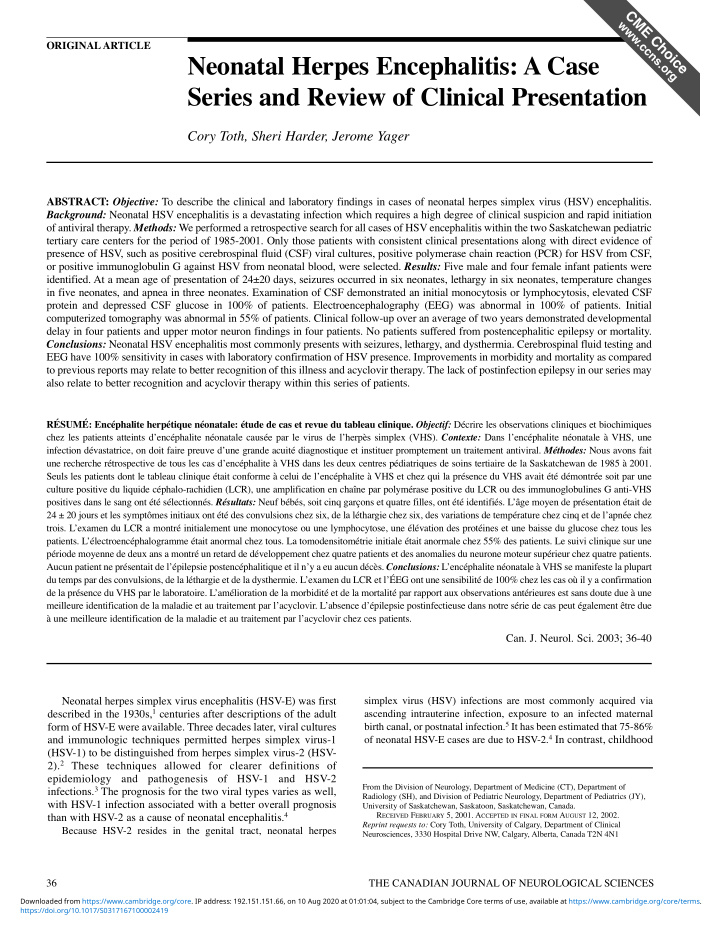



C M w E w w C . ORIGINAL ARTICLE c h c o n i Neonatal Herpes Encephalitis: A Case s c . o e r g Series and Review of Clinical Presentation Cory Toth, Sheri Harder, Jerome Yager ABSTRACT: Objective: To describe the clinical and laboratory findings in cases of neonatal herpes simplex virus (HSV) encephalitis. Background: Neonatal HSV encephalitis is a devastating infection which requires a high degree of clinical suspicion and rapid initiation of antiviral therapy. Methods: We performed a retrospective search for all cases of HSV encephalitis within the two Saskatchewan pediatric tertiary care centers for the period of 1985-2001. Only those patients with consistent clinical presentations along with direct evidence of presence of HSV, such as positive cerebrospinal fluid (CSF) viral cultures, positive polymerase chain reaction (PCR) for HSV from CSF, or positive immunoglobulin G against HSV from neonatal blood, were selected. Results: Five male and four female infant patients were identified. At a mean age of presentation of 24±20 days, seizures occurred in six neonates, lethargy in six neonates, temperature changes in five neonates, and apnea in three neonates. Examination of CSF demonstrated an initial monocytosis or lymphocytosis, elevated CSF protein and depressed CSF glucose in 100% of patients. Electroencephalography (EEG) was abnormal in 100% of patients. Initial computerized tomography was abnormal in 55% of patients. Clinical follow-up over an average of two years demonstrated developmental delay in four patients and upper motor neuron findings in four patients. No patients suffered from postencephalitic epilepsy or mortality. Conclusions: Neonatal HSV encephalitis most commonly presents with seizures, lethargy, and dysthermia. Cerebrospinal fluid testing and EEG have 100% sensitivity in cases with laboratory confirmation of HSV presence. Improvements in morbidity and mortality as compared to previous reports may relate to better recognition of this illness and acyclovir therapy. The lack of postinfection epilepsy in our series may also relate to better recognition and acyclovir therapy within this series of patients. RÉSUMÉ: Encéphalite herpétique néonatale: étude de cas et revue du tableau clinique. Objectif: Décrire les observations cliniques et biochimiques chez les patients atteints d’encéphalite néonatale causée par le virus de l’herpès simplex (VHS). Contexte: Dans l’encéphalite néonatale à VHS, une infection dévastatrice, on doit faire preuve d’une grande acuité diagnostique et instituer promptement un traitement antiviral. Méthodes: Nous avons fait une recherche rétrospective de tous les cas d’encéphalite à VHS dans les deux centres pédiatriques de soins tertiaire de la Saskatchewan de 1985 à 2001. Seuls les patients dont le tableau clinique était conforme à celui de l’encéphalite à VHS et chez qui la présence du VHS avait été démontrée soit par une culture positive du liquide céphalo-rachidien (LCR), une amplification en chaîne par polymérase positive du LCR ou des immunoglobulines G anti-VHS positives dans le sang ont été sélectionnés. Résultats: Neuf bébés, soit cinq garçons et quatre filles, ont été identifiés. L’âge moyen de présentation était de 24 ± 20 jours et les symptômes initiaux ont été des convulsions chez six, de la léthargie chez six, des variations de température chez cinq et de l’apnée chez trois. L’examen du LCR a montré initialement une monocytose ou une lymphocytose, une élévation des protéines et une baisse du glucose chez tous les patients. L’électroencéphalogramme était anormal chez tous. La tomodensitométrie initiale était anormale chez 55% des patients. Le suivi clinique sur une période moyenne de deux ans a montré un retard de développement chez quatre patients et des anomalies du neurone moteur supérieur chez quatre patients. Aucun patient ne présentait de l’épilepsie postencéphalitique et il n’y a eu aucun décès. Conclusions: L’encéphalite néonatale à VHS se manifeste la plupart du temps par des convulsions, de la léthargie et de la dysthermie. L’examen du LCR et l’ÉEG ont une sensibilité de 100% chez les cas où il y a confirmation de la présence du VHS par le laboratoire. L’amélioration de la morbidité et de la mortalité par rapport aux observations antérieures est sans doute due à une meilleure identification de la maladie et au traitement par l’acyclovir. L’absence d’épilepsie postinfectieuse dans notre série de cas peut également être due à une meilleure identification de la maladie et au traitement par l’acyclovir chez ces patients. Can. J. Neurol. Sci. 2003; 36-40 Neonatal herpes simplex virus encephalitis (HSV-E) was first simplex virus (HSV) infections are most commonly acquired via described in the 1930s, 1 centuries after descriptions of the adult ascending intrauterine infection, exposure to an infected maternal birth canal, or postnatal infection. 5 It has been estimated that 75-86% form of HSV-E were available. Three decades later, viral cultures of neonatal HSV-E cases are due to HSV-2. 4 In contrast, childhood and immunologic techniques permitted herpes simplex virus-1 (HSV-1) to be distinguished from herpes simplex virus-2 (HSV- 2). 2 These techniques allowed for clearer definitions of epidemiology and pathogenesis of HSV-1 and HSV-2 infections. 3 The prognosis for the two viral types varies as well, From the Division of Neurology, Department of Medicine (CT), Department of Radiology (SH), and Division of Pediatric Neurology, Department of Pediatrics (JY), with HSV-1 infection associated with a better overall prognosis University of Saskatchewan, Saskatoon, Saskatchewan, Canada. than with HSV-2 as a cause of neonatal encephalitis. 4 R ECEIVED F EBRUARY 5, 2001. A CCEPTED IN FINAL FORM A UGUST 12, 2002. Reprint requests to: Cory Toth, University of Calgary, Department of Clinical Because HSV-2 resides in the genital tract, neonatal herpes Neurosciences, 3330 Hospital Drive NW, Calgary, Alberta, Canada T2N 4N1 36 36 THE CANADIAN JOURNAL OF NEUROLOGICAL SCIENCES Downloaded from https://www.cambridge.org/core. IP address: 192.151.151.66, on 10 Aug 2020 at 01:01:04, subject to the Cambridge Core terms of use, available at https://www.cambridge.org/core/terms. https://doi.org/10.1017/S0317167100002419
Recommend
More recommend